Photographs: Mayur Bhatt/ Saab Press
For the second consecutive year, as the India Art Summit readies itself for the Delhi event this month, there are doubts whether it will finally include Husain's works. Or, will the fair's organisers, Hanmer MS&L, be content to have him present 'in spirit' like last year, eschewing his works with the plea that business is business, especially in lean times.
It is a supreme irony. Maqbool Fida Husain, whose place in art history is unquestionable, who was largely instrumental in making a market for Indian contemporary art in the global art scenario, unlike many whom the market will make in that barren, no man's land of 'safe' form and content, seemingly poses the biggest danger to the art summit today.
Text: Chitra Padmanabhan
'Where it is chaste, it is not art'
Image: Husain at work during a one-day India-Pakistan game in Karachi, February 19, 2006Photographs: Zahid Hussein/Reuters
Demonstrating an understanding of the conceptual underpinnings of art, the judgments commented on the need to understand a contemporary art work from the painter's perspective and on artistic principles before notching up any objections, placing these acts squarely within the rubric of Constitutional guarantees of freedom of expression and principle of pluralism.
Delhi high court Justice Sanjay Kishan Kaul's May 2008 ruling put it succinctly: 'Pluralism is the soul of democracy. There should be freedom for the thought we hate. Freedom of speech has no meaning if there is no freedom after speech. The reality of democracy is to be measured by the extent of freedom and accommodation it extends.'
To this add Justice Kaul's reminder through Picasso's quote -- 'Yes, art is dangerous. Where it is chaste, it is not art' -- or observation -- 'It seems that the complainants are not the types who would go to art galleries or have an interest in contemporary art.'
Market logic of an art fair
Image: Police confront a Husain supporter at a demonstration outside the painter's Mumbai homePhotographs: Reuters
In a news report last year, Sunil Gautam, managing director, Hanmer MS&L, stated, 'We as organisers have the highest regard and huge respect for the legend M F Husain. The artist himself understands the situation. He knows our problems -- this is public space and we are exhibiting works worth crores of rupees. I could not expose the show to any kind of risk. It was my duty to safeguard everyone's interest.'
Controversial for whom and for what reason?
Image: A visitor looks at a Husain collage of Madhuri Dixit at a Mumbai exhibition, December 4, 2000Photographs: Reuters
The statement underlines the extent to which the idea of public space has been devalued in recent times, making way for a monetised perception of space which operates like a gated community doing its utmost to keep out potential trouble and 'politics', as if that is possible.
Indeed, after clarifying that the fair was primarily meant to promote younger contemporary artists, Gautam was quoted in the report as saying, 'I wanted every frame to match the walls and told the galleries not to bring in works that would court controversy.'
What kind of a brief is that? Does the India Art Summit have a list of themes, styles or individual artists deemed controversial; further, controversial for whom and for what reason? Ultimately, the defensive reaction of the organisers has had the same exclusionary impact as the offensive response of Hindutva proponents to Husain's art. And that is scary.
More mart than art?
Image: A visitor looks at contemporary art during the India Art Summit in New Delhi, August 23, 2008.Photographs: B Mathur/Reuters
The media, which had largely fulfilled this role of creating space for debate on art, was itself undergoing a makeover to becoming a pillar of entertainment. And public institutions were awakening to the paralysing reality of adjusting to a world that was opening up.
The vacuum of informed, public articulation on contemporary art was filled up either by an 'art appreciation' rooted in a virulent form of politics or by the confidence of an art market often more mart than art, virtually becoming the touchstone of knowledge.
Ironic, considering the compulsions of a market like the art summit -- an obligation to ensure participants and visitors a 'good experience' -- could make it ignore cutting edge works capable of causing an optic disturbance in some blinkered gaze or the other. Works that stand the test of time and become the solid bottom of art markets -- what we call fundamentals.
Greatness of art is pegged at its sales figure
Image: The master at workPhotographs: Rediff Archive
True, art fairs are essentially commercial propositions. Even so, if they close their eyes to the rich markers of sensibilities contained in the works of artists like Husain, with an unarguable place in art history, they become institutions without a memory, mere art sales. In effect, art fairs lose an opportunity to gain the depth and broadness of vision to spot new contours and more energising times.
There are some ways of seeing, and showcasing, that are infinitely better than others.
Chitra Padmanabhan is a freelance journalist.

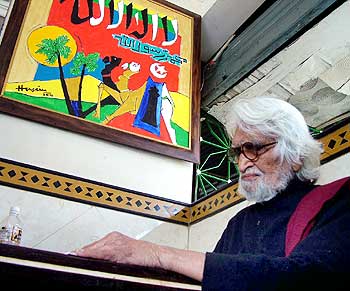
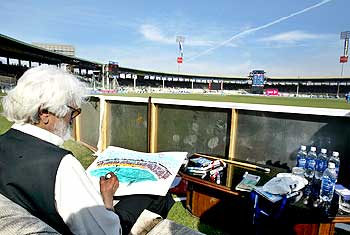
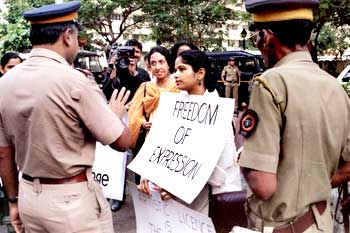
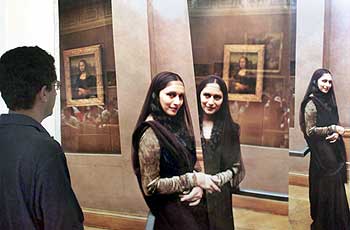
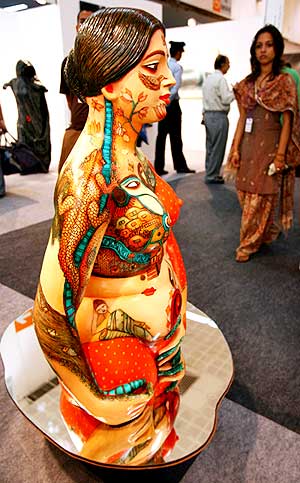
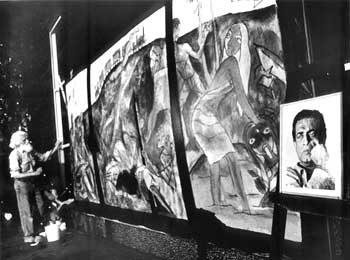
article